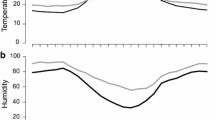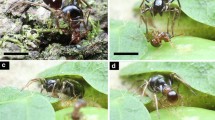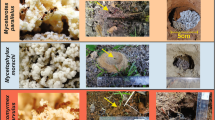Abstract
This paper presents the results of our research on the foraging activity of ants in forest–steppe biotopes of Saratov oblast. The food spectrum of ants was found to include small invertebrates (mainly insects), plant seeds, and aphid honeydew. Ants are able to switch to the most massive type of food. F. pratensis behaves as a species with a daytime or morning–evening activity type, depending on the weather conditions. F. rufa is a species with a daily activity type.
Similar content being viewed by others
Avoid common mistakes on your manuscript.
INTRODUCTION
Ants are an essential component of ecosystems. Their success is due to social organization and the ability to change habitats and use a variety of food resources. Among the ants of central Russia, species of the genus Formica are the most noticeable due to their relatively large size, large numbers of families, and prominent nests: domes of plant residues. The study of the feeding habits of ants is important in view of their potential use for biological control of conifer and leaf-eating insects. The dynamics of the daily activity of ants, like most species of invertebrates, is associated with abiotic factors such as soil temperature, moisture, solar radiation, among others, as well as biotic ones: the availability of food resources, breeding intensity, and interspecific competition (Stukalyuk, 2013). Data on the dependence of the foraging intensity of ants in a particular habitat on temperature are of undoubted interest for forestry (Pavlova et al., 2013).
The purpose of our study is to investigate the dietary habits and daily activity of ants of the genus Formica in forest–steppe biotopes of Saratov oblast. This work is a continuation and synthesis of our previous studies (Pavlova et al., 2015).
A study of the foraging of ants of the genus Formica was carried out in the daytime in June–July 2013 and May 2014 and 2016 in Khvalynskii National Park and from late July to September 2016 on the territory of Kumysnaya Polyana Natural Park. Two species of ants were chosen for observation: the red wood ant (F. rufa Linnaeus, 1761) and the black-backed meadow ant (F. pratensis Retzius, 1783). The selected families live in different biotopes: in the Khvalynsk district, two nests of F. rufa are located in a mixed forest and in a field; a nest of F. pratensis is located in the steppe. In the vicinity of the city of Saratov, two families of ants of the genus Formica inhabit an oak forest. To study the food objects, for an hour in the morning and evening, their burden was taken from the ants. A total of 1244 objects were taken (273 in July 2013 (one anthill); 556 in May 2014 (three anthills); 281 in May 2016 (three anthills); 134 in July−September 2016 (two anthills)). To determine the scatter of the proportions of food objects from different groups, the standard deviation calculated on the basis of an unshifted estimation of dispersion was used.
The study of the daily activity of ants of the species F. pratensis was carried out in the daytime (the activity of some individuals in the anthills at night until 7−8 a.m. was not taken into account) in June−July 2011 and 2012 in the floodplain of the Medveditsa River, Lysogorskii district of Saratov oblast; the activity of F. rufa was studied in June−July 2013 in Khvalynskii National Park. To assess the overall activity of the family, ants crossing the demarcated line (thread) were registered for five minutes and individuals exiting and entering the nest were taken into account (Zakharov and Goryunov, 2009).
It is important to note that the temperature limits of foraging activity are not an absolute property of the species and may vary in individuals of the same family within a wide range (about 3−5°C), depending on the adaptation to high (or low) temperatures. The optimum temperature depends on the conditions in which ants live. For example, individuals of F. rufa grown at 3–4°С prefer a temperature of 23–24°С, and those grown at 25–27°С prefer a temperature of 31−32°C (Dlusskii, 1967). Based on this temperature correlation of the development and existence of ants, the entire observation period for weather conditions was divided by the authors into warm days with an average temperature of 27°С (max 35, min 17), rainy days with an average temperature of 20°C (max 21, min 19), and hot clear days with an average temperature of 31°C (max 39, min 20). The temperature measurement of the surface air layer was made once per hour with a TTS-1200 digital thermometer (Teploavtomatika, Russia). A total of 29 618 ants were counted. The statistical significance of the data obtained on days with different weather conditions was determined using the Wilcoxon test for samples with dependent variables. Statistical processing was carried out in the Statistica 6.0 software package.
As the results of the observations showed, the main feeding objects of red wood ants were small invertebrates (no more than 25 mm). They were imagoes of insects and their larvae from the orders Lepidoptera, Coleoptera, Hemiptera, Diptera, Hymenoptera, Orthoptera, Ephemeroptera, Odonata, Dermaptera, Trichoptera, and Raphidioptera. From other classes, we found woodlice (class Malacostraca, order Isopoda), spiders (class Arachnida, order Aranei), and centipedes (class Chilopoda, order Lithobiomorpha); and from the class of oligohaeta worms (Oligohaeta), earthworms (order Haplotaxida, family Lumbricidae). In small amounts, linden, birch, and hawthorn seeds were present (Table 1). As carbohydrate food, the ants used the honeydew of aphids feeding on plants and leaves of trees at a distance of 2–30 m from the nests.
Table 1 shows that the dominant groups in the diet of ants of the genus Formica in July 2013 were mayflies (26%), beetles (21.6%), butterflies (13.9%), and dipterans (10.6%). In the spring of 2014, the food spectra of ants from different biotopes were similar. The main food object―the march fly (Bibio)―ranged from 58.3 (an anthill in the steppe) to 77.3% (an anthill in the field). By the averaged data, most of the food objects were dipterans and lepidopterans: 65.5 and 9.5%, respectively. In May 2016, the ratios of food objects in different biotopes were different. The majority (45.2%) of the food objects of ants in the forest fell on Lepidoptera (mostly the caterpillars of owlet moths). In addition, this family had the most varied diet: only they had earwigs, woodlice, and snakeflies. The family living in the field mainly procured insects from three orders: Hymenoptera (37.1%), Lepidoptera (34.3%, the caterpillars of owlet moths prevailed), and beetles (20%). In the meadow ants, the food staples were Diptera (39%), beetles (26.8%), and Hymenoptera (24.4%), and the average composition spectrum consisted of Lepidoptera (35.6%), Hymenoptera (21.4%), and Coleoptera (16%).
In the ants of the genus Formica, in the woodland in the vicinity of the city of Saratov, insects from the following orders were most often found among the prey: Hymenoptera (23.9%), Coleoptera (22.4%), and Diptera (13.4%).
In Khvalynskii National Park, during one hour of observations in July 2013, on average, 27.3 objects were extracted, in May 2014, 42.5 objects, and in May 2016, 11.2. In the forest biotopes in the vicinity of Saratov (Kumysnaya Polyana Nature Park), the average number of objects extracted per hour of observation was 5.4. The greater consumption of protein foods in spring 2014 can be explained by the preparation of anthills to the departure of a winged reproductive individual, which occurred at the end June. During the observation period in May 2016, weather conditions were less favorable for the life of ants. The average air temperature in the daytime in the forest was 15°С (maximum 22°С, minimum 10°С), which led to a decrease in the activity of working ants, especially foragers.
Another component reducing the “flow” of foraging activity in Kumysnaya Polyana Nature Park may indirectly indicate the degradation of the observed ant families due to the high anthropogenic load on the territory. The laying of hiking trails and paths for cyclists at a distance of 10 to 15 meters from the nests adversely affects the condition of ant families.
In the course of research, differences in the food spectra of ants were determined by year and season. Thus, the mean square deviation of the shares falling to a certain group of food objects is the highest indicator for May 2014 and 2016 in Khvalynskii National Park (σ = 18.2 and σ = 11.1, respectively), then for July 2013, σ = 8.4, in the same place, and the lowest values were registered in August–September 2016 in Kumysnaya Polyana Nature Park, σ = 8.2. The greater the value of this indicator, the greater the proportion of a small number of groups of food objects, i.e., in the spring of 2014, almost 2/3 of the spectrum was occupied by Diptera, and in the spring of 2016, more than 1/3 were Lepidoptera. These data confirm the reactivity of the food of the species studied; i.e., they switched to feeding on the most widespread species of edible invertebrates. These data confirm the participation of Formica ants in the regulation of pests in forest and forest–steppe biotopes.
By the period of activity, day ants can be divided into morning and daytime types. In the species with a morning–evening rhythm of activity, the daily foraging break is forced and is determined only by a high temperature. The temperature at the surface of the soil determines the duration of the day break. All the differences between these types are reduced to different resistance to high temperature and low humidity (Dlusskii, 1981).
The analysis of observations of ant activity in different weather conditions in the forest–steppe biotopes of the study area showed the presence of some features. Thus, statistically significant differences were established for the samples with dependent variables between the activity of F. pratensis on warm and hot days (Wilcoxon test: W = 3.14, p = 0.02); warm and rainy days (W = 4.806, p < 0.001). Statistically significant differences between the activity on hot and rainy days were registered. On warm days, F. pratensis showed uniform activity: the average number of individuals counted was only 1.3 times less than the maximum. After 21 hours (day) at a temperature of 21°C, the activity fell sharply: the number of ants recorded decreased more than twofold (Fig. 1). On hot days, activity peaks were more pronounced because the average number of individuals counted was two times less than the maximum. From 2 to 4 p.m., activity ceased altogether; at this time the temperature of the surface layer of the air rose to 38−39°С (Fig. 2).
On a rainy day, the number of recorded individuals decreased 1.6 times compared with the number of individuals on warm, clear days, but the activity of the family continued throughout the day. As an example, we examine the family of F. rufa from a forest biotope in the Khvalynskii district, where during the day the temperature of the surface air did not rise above 28°C (the average was 24°C), but throughout the entire day sufficiently even activity of ants was observed. Maximum activity was observed in the first half of the day (until 14:00), when the average number of recorded individuals leaving the anthill during this time was 1.5 times more than the number of individuals counted after 14:00 and 2.4 times more than the minimum for the day. After 19:00, the number of individuals returning to the anthill increased sharply, which was three times more than the number of individuals leaving it. After 21:00, at a temperature of 22°C, the activity dropped; the number of individuals counted was 2.7 times less than the average for the day and 3.6 times less than the maximum for the day (Fig. 2b). Based on the data obtained, it can be concluded that, depending on the weather conditions, F. pratensis behaves as a species with a day or morning–evening type of activity. A break in foraging on hot days is forced and is due to the high temperature of the surface air layer (38–39°C). At the same time, a different species of ants―F. rufa―manifests itself as a species with the day type of activity with maximum activity in the morning (until 14:00).
Thus, the established features of the foraging activity of ants of two species from the genus Formica from the forest–steppe biotopes of Saratov oblast showed that the basis of food for ants are small insects and their larvae from the orders Lepidoptera, Coleoptera, Diptera, and Hymenoptera. It was revealed that the ants of the species studied are able to switch to the most widespread type of food that appears in the family’s habitat, thereby contributing to regulation of the number of common insect species in the biotope at the current time. Both species of ants are active during the daytime, but Formica pratensis has a “forced break” in activity during the daytime due to high air temperatures in the open areas of the landscape.
REFERENCES
Dlusskiy, G.M., Murav’i roda Formica (Ants of the Genus Formica). Moscow: Nauka, 1967.
Dlusskiy, G.M., Murav’i pustun’ (Desert Ants), Moscow: Nauka, 1981.
Pavlova, N.S., Anikin, V.V., and Voronin, M.Yu., Specific features of the daily activity of ants (Hymenoptera, Formicidae) in Saratov oblast, Izv. Saratov. Gos. Univ.,New Ser.: Khim. Biol. Ekol., 2013, vol. 13, no. 4, pp. 73–76.
Pavlova, N.S., Anikin, V.V., and Riga, E.Yu., Biological features of ants (Hymenoptera, Formicidae) in the Khvalynsky National Park, Saratov oblast, Izv. Saratov. Gos. Univ.,New Ser.: Khim. Biol. Ekol., 2015, vol. 15, no. 4, pp. 78–82.
Stukalyuk, S.V., Daily activity of ants (Hymenoptera, Formicidae) in multispecies assemblages in the mountain Crimea, Tr. Russ. Entomol. Obshch., 2013, vol. 84, no. 2, pp. 114–128.
Zakharov, A.A. and Gorynov, D.M., General methods of field ecological research, in Murav’i i zashcita lesa: Mat.-ly XIII Vseros. mirmekol. simp. (Ants and Forest Protection: Proc. XIII All-Russia Myrmecological Symp.), Nizhny Novgorod: Nizhegorod. Gos. Univ., 2009, pp. 247–256.
Author information
Authors and Affiliations
Corresponding author
Ethics declarations
The authors declare that they have no conflict of interest. This article does not contain any studies involving animals or human participants performed by any of the authors.
Additional information
Translated by N. Smolina
Rights and permissions
About this article
Cite this article
Pavlova, N.S., Anikin, V.V. Foraging and Daily Activity Features of Ants of the Genus Formica (Insecta, Hymenoptera) in Forest–Steppe Biotopes of Saratov Oblast. Biol Bull Russ Acad Sci 46, 1313–1316 (2019). https://doi.org/10.1134/S1062359019100248
Received:
Accepted:
Published:
Issue Date:
DOI: https://doi.org/10.1134/S1062359019100248






